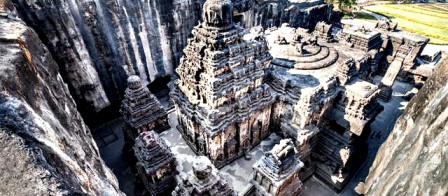The Rashtrakuta Dynasty – History Study Notes & Stuff
History of Rashtrakuta Dynasty, Art and Architecture
The Rashtrakutas came to power among the dynasties of South India between the 6th and 10th centuries. According to popular belief, they were of Kannada origin. Rashtrakutas capital was Malkhed near Solapur. The geographical location of the Rashtrakutas joined their alliance as well as war with both their northern and southern neighboring states. It is recorded that earlier rulers of the Rashtrakuta dynasty were Hindus but later rulers were Jains.
Dandidurga, the founder of Rashtrakuta Dynasty:
The founder of the Rashtrakuta dynasty was Dantidurga (752–756 AD) who defeated the Gurjaro and snatched Malwa from them. Later he defeated the Kirtivarman II and established the Chalukya Empire.
Krishna I of Rashtrakuta Dynasty
Krishna I was the son of Dantidurga and a great conqueror who defeated the Eastern Chalukyas of the Ganga dynasty and Vengi. He expanded the boundaries of the Rashtrakuta empire. He is remembered for establishing the rock-cut monolithic Kailash temple at Ellora.
The next important ruler of the Rashtrakuta dynasty was Govinda III who conquered many North Indian states and extended the Rashtrakuta empire from Benares to Broach and Kannauj to Cape Comorin. This was during a time when the tripartite struggle for control over Kannauj was between the Pallas, Rashtrakutas and Pratiharas.
Longest reigning king of Rashtrakuta Dynasty, Amoghvarsha I
Amoghavarsha was the successor of Govinda III. He is considered the greatest ruler of the Rashtrakuta dynasty who ruled for 64 years. He was a devout Jain who was initiated into Jainism by Jinasena. Amoghavarsha was a patron of arts and was the author of "Kavirajmarg" in the Kannada language itself. Amoghavarsha I is credited with establishing the Rashtrakuta capital in Malkhand or Malkhed located in Gulbarga district of Karnataka and remained the capital of the Rashtrakuta empire till its fall.
After defeating the Eastern Chalukyas, Amoghavarsha I assumed the title of Veeranarayana. His reign was peaceful and he supported and enriched art, literature and religion in the empire. He was a religiously tolerant ruler who took a keen interest in art and literature while maintaining peace in his empire, for this reason he is often called the "Ashoka of the South".
Krishna II of Rashtrakuta Dynasty:
Krishna II was the successor of Amoghavarsha I. During his reign there were rebellions from the Eastern Chalukyas and hence the size of the empire diminished.
Krishna III, the last prominent ruler of Rashtrakuta Dynasty:
Krishna III consolidated the empire that had been shattered by a series of weak kings before him. He defeated the Cholas at the Battle of Takkolam and captured Tanjore, after which he expanded further into Rameswaram. He also got the Gandhimandramaditya and Krishneshwar temples constructed at Rameswaram. Shantipurn was written by the great Kannada poet Ponna during his reign.
The last ruler of the Rashtrakuta dynasty was Karka II.
Administration under Rashtrakutas:
The provinces under the Rastrakutas were known as 'Rashtra'. They were under the control of the province 'Rashtrapati'. These nations were divided into "Vaishyas" ruled by "Vihiyapati" and the next subdivision under Vishnu was Bhukti which consisted of fifty to seventy villages under Bhogapati (directly appointed by the central government). Gram sabhas played an important role in furthering the administration of the village.
Society and Economy of Rashtrakutas:
Vaishnavism and Shaivism were both major religions during the Rashtrakuta reign. While one third of the population was following Jainism, and Kanheri, Sholapur and Dharwad had many proper Buddhist settlements.
learning centers also developed at places under Rashtrakuta. A college at Salotgi in Bijapur district was run by the endowment of income made by rich people and villagers.
Trade and commerce between Deccan and Arabs. Rashtrakuta has good relations with Arab traders.
Art and Culture during Rashtrakutas :
The Rashtrakutas patronized Sanskrit literature and under the Rashtrakutas, Trivikram wrote "Nalachampu", Halayudha wrote "Kavirahasya" during the reign of Krishna II.
Amoghavarsha patronized the Jain scholars and his teacher Jinasena wrote "Parsharvabhudaya" containing verses about Parshvanath. Under his patronage, the development of Kannada literature began and in fact Amoghavarsh's Kavirajamarg is a poetic work in Kannada.
Under the Rashtrakutas, Gunabhadra wrote "Adipuran" which is based on the lives of Jain saints, Sakatayana wrote the grammar "Amogavritti" and the mathematician, Viracharya wrote "Ganitsaram".
Pampa and Ponna were the two great Kannada poets during the Rashtrakuta rule. Ponna wrote 'Shantipurana' and Pampa wrote 'Vikramasenavijaya'.
Architecture under Rashtrakuta dynasty:
The Rashtrakuta architecture is depicted by Ellora and Elephanta.
Kailashnath temple at Ellora.
It was built under Krishna I. The temple is carved out of a huge rock 200 feet long and 100 feet in width and height and has four parts - the main shrine, the entrance, the intermediate shrine for Nandi and a pavilion Aron the courtyard. The Kailash temple at Ellora is 25 feet high, endowed with elephant and lion figures. The three-tiered Shikhara resembles Shikara of Mammalapuram Rathas. It has sculpture of Durga slaying buffalo demon. Another sculpture has Ravana improved to lift Mount Kailash. There are scenes from Ramayan carved out on the walls of the temple. This temple is considered a piece of Dravidian style of Architecture.
The Elephanta Caves of Rashtrakutas:
Elephanta caves Dwarpalak
The Elephanta Caves
Elephanta caves situated at an island near Mumbai, were originally known as Sripuri. The Portuguese later named it so due to the large Elephant sculture it had. There is a close similarity between the Ellora temple and Elephanta caves depicting continuity of craftsmen. At the entrance of the elephanta caves are huge figures of the dwra-palakas. The wall around the sanctum houses the idols of Nataraja, Ardhanareeswara, Gangadhara, Somaskanda and Trimurthi.
We hope that this short notes about The Rashtrakuta Dynasty is useful for your quick revision. If you want us to add any more details to this article, please do let us know in the comments below.










0 Comments